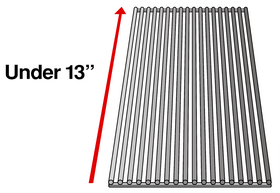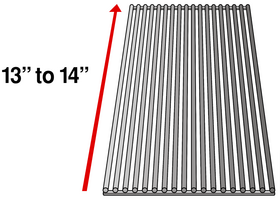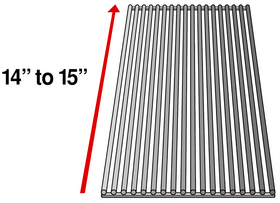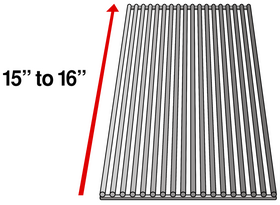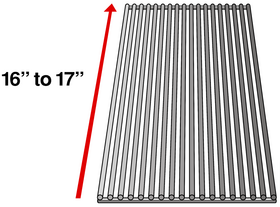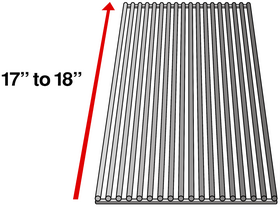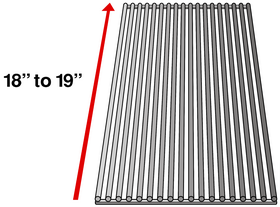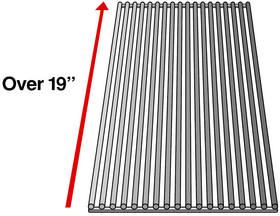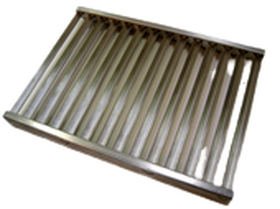Grill Grates
Grill grates, also known as grill grids or grill racks, are the parts of the grill where your food sits. Grates can rust, chip, or collect various gunk over time, so ensuring they are of good quality is important for both safety and taste! Find out if you need replace yours below.
Why Buy New Grill Grates?
Rust on the Grill
Eventually, grill grates deteriorate and rust. Rust can add a metal flavor to your food and cause the food to stick to the grate. Rust can even flake off and get into your food. Small amounts of rust might be okay, but over time can lead to serious health issues. If the rust doesn’t come off with a wire brush, it’s time to replace your grill grate.
Chipping
This generally occurs on grill grates that have a porcelain coating or are stainless wrapped rod grates. It’s only a matter of time until these grates start to chip. If they are dropped, banged, or cleaned with improper tools, the porcelain starts to chip away which exposes the steel underneath leading to rust. It’s also possible for porcelain chips to end up in the food being grilled. Once chipping becomes a problem, it’s time to replace your grill grate. Stainless wrapped rod grates will eventually bust exposing the steel rod it covers. Once this occurs, the grate will need to be replaced.
Cleaning
If you have had your barbecue grill for a while, you have probably noticed that the grease and fat from the meat you cook can make a mess on the different grill parts. Over time, the grates that you use to cook the meat can become encased with debris from cooking, even if you habitually clean and oil the grates. In these cases, you can get more flavor and enjoyment out of your barbecuing experience by replacing your grill grates.
(Routinely cleaning your grill grates, after every cookout, and providing periodic thorough cleaning, will help your grates last longer, improve your cooking experience, and help prevent food from sticking. For more information on cleaning grill grates, please see the previous page.)
How to Measure Size for Replacement Grill Grates?
Cooking grids are measured in depth (front to back). Take a tape measure and measure the grate front to back first. The front to back, or depth, is the dimension if you are standing in front of your grill. This is an important dimension because you want your replacement grill grate to fit on the shelves inside the firebox. If this is not measured correctly, the grate will fall through or just not fit at all.
You may also want to note the maximum and minimum depth range from the shelf in the grill in the event there is not an exact fit. Then measure the width, left to right, and count the number of grids in your grill. First, you’ll want to choose the appropriate depth range (see below) for your cooking surface, and then choose the appropriate width.
Types of Grill Grates
There are three main types of replacement grill grates available. Let’s go over each grate’s details.
Stainless Steel Grill Grates
Stainless steel grill grates are relatively easy to maintain and clean than other types of replacement grill grates. They are durable and perform well. They do no get as hot as cast iron, but retain heat well. Eventually, stainless steel grates tend to lose their nonstick qualities and food starts to stick to the grid. But if you’re looking for a low-maintenance replacement grill grate, stainless steel is a wise option.
Porcelain Grill Grates
Porcelain grill grates are made out of metal that’s covered with a heavy enamel coating. The porcelain coating protects the steel underneath and makes the grates easier to clean (just be careful, as the finish can chip). However, they can chip over time, eventually leading to rust issues. However, if a quality porcelain grill grate is chosen, such as the options we offer at the BBQ Depot, the chipping should not be an issue. It is also important to note that porcelain grill grates should not be cleaned with metal scrapers, as it will damage the porcelain coating. Cleaning with the proper tools will help keep the integrity of the coating for a much longer period of time.
Cast Iron Grill Grates
The heavier the better when it comes to cast iron grill grates. Cast iron can get much hotter and retain the heat better than stainless steel or porcelain. Because it gets hotter it can give the backyard chef the sear marks they desire. Just be aware, despite the excellent performance of cast iron grill grates, they are more prone to rust, so they require more maintenance and care but are well worth the effort.
Can You Use a Different Type of Grill Grate on Your Grill from the One It Came with?
Yes! As long as the measurements are appropriate and they fit on the grill, you can use different grates from the ones your grill came with. For instance, if your grill came with porcelain coated grates and you don’t want to ever have to deal with chipped grates again, consider replacing them with cast iron or stainless steel grates of the same size and dimensions.
If you’re ready to buy, get new grill gates for your Alfresco grill, Twin Eagles grill or Weber grill today! If you’re not sure which replacement grill grate is right for you, feel free to contact us and we’ll be happy to help you decide.

